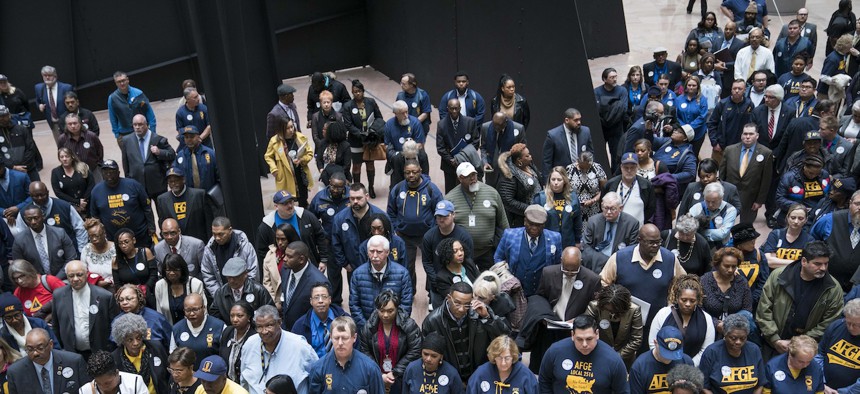
Members and supporters of the American Federation of Government Employees in the Hart Senate Office Building Atrium in Feb. 11, 2020. The EEOC has recommended that agencies undertake efforts to identify and address barriers that create gender pay differences among federal workers. Sarah Silbiger/Getty Images
EEOC: The federal gender pay gap gets worse with age
The discrepancy between what men and women make in the federal government is substantially larger for those over 40 years old than that of their younger counterparts.
The gender pay gap is much more pronounced among older federal workers than their younger counterparts, according to a new report by the Equal Employment Opportunity Commission.
Using 2021 HR data from the Office of Personnel Management, EEOC said it measured the gender pay gap across age groups several different ways, but each time, the pay gap among feds older than 40 was larger than among those younger than 40. By one metric, the gender pay gap was three times larger among the older category of workers.
“Gender pay gaps are larger for older employees,” said Karen Brummond, an EEOC social science research analyst in a statement. “Over a lifetime, this adds up. A small gender pay gap early in one’s career can multiply into a larger gap over time.”
Overall, women under age 40 were paid an average of $2,608 less than men in the same age bracket on an annual basis, while women 40 and older were paid $6,927 less than their corresponding male counterparts. That corresponds with a gross gender pay gap of 3.6 cents on the dollar for federal workers under 40 and a gap of 7.4 cents on the dollar for those 40 and older.
EEOC’s analysis found that the two largest factors increasing the gender pay gap were the amount of a federal worker’s experience in government, which increased the pay gap among younger workers by 2.9 cents on the dollar and added 0.8 cents on the dollar to the gap for those 40 and older, and occupation, which increased the gap by 1.6 cents per dollar for those under 40 and by 2.1 cents among the older cohort.
Conversely, a federal employee’s status as a veteran decreased the pay gap by 1.6 cents on the dollar for younger feds and 1.4 cents per dollar for those 40 and older. And education accounted for a 2.3 cents per dollar decrease to the pay gap for younger employees, compared to a 0.3 cent decrease for those 40 and older, as women entering the federal workforce are more likely to have attained advanced college degrees than men.
The report suggests that one possible driver of the late-career gender pay gap is simply the passage of time.
“Cumulative disadvantage may help explain why the older age group had larger gender pay gaps,” EEOC wrote. “A cumulative disadvantage occurs when an initial advantage or disadvantage—for example, a relatively small pay gap at younger ages—leads to larger differences over time.”
EEOC recommended that agencies should undertake efforts to identify and address barriers that create gender pay differences, particularly among those 40 and over, and that efforts to decrease the gender pay gap should focus on agencies with the largest pay gaps.
The Biden administration has taken some action in recent years to try to tamp down on pay gaps both across gender, ethnicity and other demographic characteristics, banning the use of job candidates’ salary history as part of the hiring and pay-setting process at federal agencies. But federal agencies on Wednesday withdrew a similar proposal that would have banned the use of salary history by federal contractors during their own hiring processes, citing the “limited time” remaining before President-elect Trump’s inauguration later this month.







